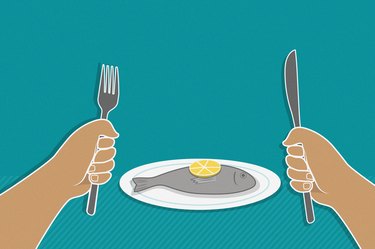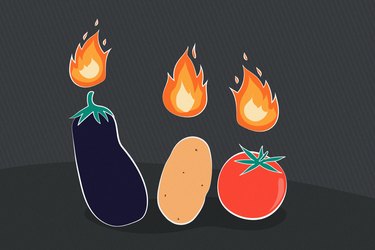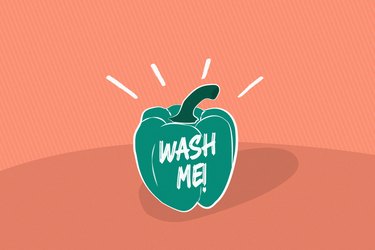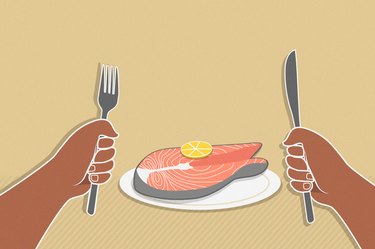
There's no shame in relishing the hamburger, but if you're like most Americans, you should be eating more fish.
"The main benefit of fatty fish like salmon, beyond the protein, is DHA omega-3 fatty acids. Most of us aren't getting enough of them and they are vital for heart, brain and eye health, as well as for a healthy pregnancy," says Frances Largeman-Roth, RDN, registered dietitian nutritionist and author of Smoothies & Juices: Prevention Healing Kitchen.
Video of the Day
Video of the Day
There are three different types of omega-3 fatty acids: alpha-linolenic acid (ALA), eicosapentaenoic acid (EPA) and docosahexaenoic acid (DHA). Your body converts ALA into EPA and then DHA, according to the National Institutes of Health (NIH).
"While ALA fatty acids are found in plants (like flax, hemp and chia seeds and walnuts), the conversion of ALA to DHA omega-3 is very low," Largeman-Roth says. So in order to get enough EPA and DHA, you'll need to get the bulk of it from fatty fish, like salmon.
When it comes to choosing fish, salmon is a common choice because of its availability and healthy reputation. The problem is that cheaper and more accessible cuts of salmon are typically farmed. Read on to find out if farm-raised salmon is bad to eat.
Farmed vs. Wild Salmon
Both wild-caught and farm-raised salmon are excellent sources of omega-3s. The main difference between wild and farmed salmon is that the latter is raised in farms for us to eat whereas wild salmon is caught in open water, says Michelle Jaelin, RD.
It might surprise you to learn, though, that farmed salmon actually has more omega-3 fatty acids than wild salmon, Jaelin says.
"It's like choosing between chicken breast and dark meat. Wild salmon is much leaner while farmed salmon holds flavors better because it has more fat. That's why chefs like to cook with farmed salmon."
"Farmed salmon is higher in fat because of what they're fed. They are usually fed more grains, algae and fishmeal in the farms, which increases their omega-3 fatty acid content. The skin of the fish is actually where you'll find the most omega-3 fats," Jaelin says.
Chefs sometimes even prefer to use farmed salmon in dishes due to its fat content.
"It's like choosing between chicken breast and dark meat. Wild salmon is much leaner while farmed salmon holds flavors better because it has more fat. That's why chefs like to cook with farmed salmon," Jaelin says.
Farmed and wild salmon differ slightly in their other nutrient profiles, too. "Farmed salmon is higher in folate and vitamin A than wild salmon, but wild salmon is higher in potassium and selenium," Jaelin says.
Omega-3 and Omega-6 Fats in Farmed Salmon
The amount of omega-3 fatty acids found in wild salmon is dependent on the algae and plankton in their diet, per the Washington State Department of Health. On the other hand, the ingredients in fish feed determine the amount of omega-3 fats in farmed salmon.
New salmon feeds are currently being developed that have more protein derived from grains and soybeans — and fish oil is also being partially swapped for plant-based oils, per the Washington State Department of Health.
Some feeds made with oils from soybeans, corn, nuts and wheat are high in omega-6s, per the Global Aquaculture Alliance. Fish farmers often use canola oil in feed because it contains only twice as many omega-6 fatty acids than omega-3s, for a ratio of 2:1. Meanwhile, soybean oil can have as high as an 8:1 ratio of omega-6s to omega-3s.
Overall, farmed salmon has more omega-6 fats than wild salmon, per a May 2017 study in Environmental Research. A 4-ounce fillet of cooked farmed Atlantic salmon has 755 milligrams of omega-6 fats. The same serving size of wild Atlantic salmon has 249 milligrams of omega-6 fats.
Farmed salmon has an omega-6 to omega-3 ratio of about 1:4, while wild salmon has an omega-6 to omega-3 ratio of 1:10, per a November 2005 study in the journal Environmental Science & Technology.
Although omega-6 fats don't have the same healthy reputation as omega-3 fats, they're also good for you (despite rumors that they can cause inflammation). Research shows that omega-6 fats can actually reduce inflammation markers or leave them unchanged, per Harvard Medical School.
Tip
The latest nutrition guidelines recommend eating unsaturated fats like omega-3s and omega-6s in place of saturated fat. Although Americans tend to eat about 10 times more omega-6s than omega-3s (which are important for heart health), that doesn't mean you have to cut out your omega-6 fats. Instead, try eating more omega-3 fats to make these two types of fat more balanced in your diet, per Harvard Medical School.
What Are PCBs in Farmed Salmon, Anyway?
The downside of choosing farmed salmon is the risk of eating persistent organic pollutants, otherwise known as POPs. One type of POP that's commonly found in farmed salmon is polychlorinated biphenyl (PCB), which are man-made chlorinated industrial chemicals, per the Cleveland Clinic.
Although the U.S. government banned the production of PCBs in 1977, they are slow to break down. PCBs were previously released into the environment from hazardous waste sites, landing at the bottom of riverbeds, lakes and coastal areas where they can enter the food chain and affect fish, according to the Environmental Defense Fund (EDF).
Farmed salmon has 16 times the PCBs found in wild salmon, 3.4 times the amount in other seafood and 4 times the amount in beef, according to the Environmental Working Group (EWG). And the prevalence of PCBs in farmed salmon is usually found in the Atlantic variety (those raised in net pens), Jaelin says.
"Some studies have shown that that farm-raised salmon varieties can be higher in contaminants due to the closed system environment they are raised in as opposed to open waters. Farm-raised fish tend to have a higher instance of disease due to farming conditions," Largeman-Roth says.
The PCBs in farmed salmon are usually found in the feed, which can be made up of smaller fish like herring and anchovies, according to Harvard Health Publishing. Salmon farms also usually have fish excrement and uneaten feed under the net pens. Sea lice can also infect farmed salmon, which can negatively affect the salmon's health, per the Washington State Department of Health.
That doesn't mean wild salmon is without PCB risks. A small November 2020 study in Foods analyzed the fatty acid, PCB and heavy metal content in farmed, escaped and wild Atlantic salmon in Norway, and found that the concentrations of PCBs and heavy metals, such as mercury and arsenic, were three times higher in wild salmon than farmed varieties.
But these PCB levels were still below the European Union's standards for contaminants in food. And researchers believe that the shift in feed for farmed salmon from marine to vegetable ingredients reduced their PCB and heavy metal levels.
Researchers also found that farmed and wild salmon had similar essential amino acid profiles, but wild salmon had a slightly higher protein content. While this study is small, it brings to light the environmental challenges in wild salmon and the need for improving fish farming in general.
The Health Risks of PCBs in Fish
Even though exposure to PCBs can affect wild salmon populations, Largeman-Roth says that it's generally nowhere near the level of contaminants in farmed salmon. Case in point: A large 2004 study found that the PCBs in farm-raised salmon were about eight times higher than the concentrations in wild salmon, per Harvard Health Publishing.
"The PCBs in salmon have been associated with cancer and other health issues. One of the reasons they are so potentially harmful to health is that they are stored in fat rather than excreted, which means they accumulate in the body over time," Largeman-Roth says.
For example, a November 2018 PLOS One meta-analysis showed that exposure to certain PCBs is linked to breast cancer risk. And exposure to certain PCBs is associated with the development of type 2 diabetes, especially among women and people without obesity, according to an August 2019 Environmental International study.
In addition, a March 2015 study in the International Journal of Cardiology, which included 33,446 middle-aged and older women with no history of heart disease or diabetes, found PCBs exposure was associated with an increased risk of a heart attack. There was also some beneficial effect associated with increasing EPA and DHA intake.
While these studies don't directly tie the level of PCBs in farmed salmon to the associated health risks, they reveal that general PCB exposure can have a negative effect on your health.
Do the Benefits of Farmed Salmon Outweigh the Risks?
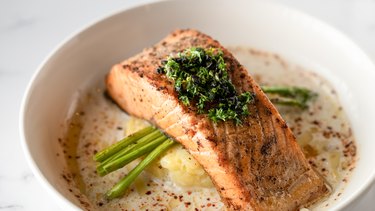
It depends on who you're asking. Jaelin says that the levels of PCBs found in farmed salmon are generally considered safe by government standards. FYI, the Food and Drug Administration (FDA) deems any fish with PCB levels greater than 2 parts per million (ppm) as unsafe.
But the EWG claims that the FDA's guidelines are outdated compared to the Environmental Protection Agency's (EPA) updated standards for PCB levels. The FDA doesn't consider the cumulative effect of exposures to different types of PCBs altogether. The FDA's guidelines are for individual chemical classes but not "complex mixtures of hundreds of industrial chemicals to which people are exposed," the EWG writes.
Essentially, if you were to go by the EPA's standards, then you wouldn't eat farmed salmon more than once a month. For this reason, Largeman-Roth says your safest bet is to go wild.
"I recommend looking for wild salmon and other seafood out of Alaska, which supplies 95 percent of the wild salmon in the U.S. Studies have also shown lower levels of PCBs in wild salmon from the glacier-fed waters of Alaska versus other areas, like Ireland and Scotland," she says. "Alaska also adheres to strict sustainability standards, helping to ensure long-term access to wild salmon and avoid dependency on farmed varieties."
Both Jaelin and Largeman-Roth agree that most people don't eat nearly enough fish — only one in five adults eats enough, according to the Food Marketing Institute's 2019 Power of Seafood. FYI, the 2020-2025 Dietary Guidelines for Americans recommend that adults eat at least 8 ounces of seafood, or two 4-ounce servings, each week.
That's why both dietitians recommend you stick to two servings of fatty fish each week — whether that's farmed or wild salmon.
"To me, the benefits of eating farmed salmon outweigh their risks. If people aren't eating a lot of fish, are they really getting too many PCBs? It's the dose that makes the poison," Jaelin says.
"If you're going to eat salmon more than twice a week, then I would recommend going for wild salmon to reduce your risk of PCB exposure. But if you eat fish less than twice a week, then eating farmed salmon is fine," Jaelin says.
That said, if you're really concerned about the health risks of PCBs, there are other ways to get more omega-3s into your diet. "You can get omega-3s from other fish, such as herring, mackerel and sardines. Walnuts and chia seeds are also high in omega-3s," Jaelin says.
Tip
The FDA recommends removing the skin, fatty areas and internal organs from fish before eating because these areas are where pollutants accumulate, especially if the fish was caught in local waters.
Grilling or broiling fish allows the fat to drain or drip away, unlike frying or deep-frying it, per the Maine Center for Disease Control and Prevention.
"I still recommend that people at two servings of fatty fish per week. Studies show that it can cut your risk of dying from heart disease by 36 percent. But just like I recommend variety in other parts of your diet, I also advise eating different types of seafood for maximum benefits with minimum exposure," Largeman-Roth says.
"From my perspective, some fatty fish in the diet is better than no fatty fish."
So, Is It Bad to Eat Farmed Salmon?
There are health risks to eating farmed salmon, especially if you eat it more than twice a week. But generally speaking, having some farmed salmon is better than having no salmon in your diet.
"I would choose wild salmon, especially from Alaska, over farmed salmon for the safest choice for my body and the environment. However, the overall health benefits of all seafood are most likely more beneficial to your body than omitting seafood from your diet," Largeman-Roth says.
With that said, vary your diet and be sure to eat different types of fatty fish and seafood, like anchovies, sardines, tuna, cod, black sea bass, Atlantic mackerel, oysters, shrimp and scallops. Canned fish and seafood are great options if you're too tired to cook or are in a pinch.
Tip
If you're still unsure about the salmon you're eating, the EDF put together this helpful seafood selector guide, in partnership with the Monterey Bay Aquarium Seafood Watch, which rates different salmon species based on their environment and mercury and omega-3 levels.
- National Institutes of Health: "Omega-3 Fatty Acids"
- Food Marketing Institute: "The Power of Seafood 2019: An In-Depth Look at Seafood Through the Shopper's Eye"
- Dietary Guidelines for Americans 2020-2025
- Washington State Department of Health: "Farmed Salmon vs. Wild Salmon"
- Cleveland Clinic: "Fish Faceoff: Wild Salmon vs. Farmed Salmon"
- Environmental Defense Fund: "PCBs in Fish and Shellfish"
- Environmental Working Group: "PCBs in Farmed Salmon"
- Harvard Health Publishing: "Getting your omega-3s vs. avoiding those PCBs.—The Family HealthGuide"
- Food: "An Update on the Content of Fatty Acids, Dioxins, PCBs and Heavy Metals in Farmed, Escaped and Wild Atlantic Salmon (Salmo salar L.) in Norway"
- PLOS One: "Environmental Polychlorinated Biphenyl Exposure and Breast Cancer Risk: A Meta-Analysis of Observational Studies"
- Environmental International: "Persistent Organic Pollutants and the Incidence of Type 2 Diabetes in the CARLA and KORA Cohort Studies Author Links Open Overlay Panel"
- International Journal of Cardiology: "Dietary Exposure to Polychlorinated Biphenyls and Risk of Myocardial Infarction — A Population-Based Prospective Cohort Study"
- Food and Drug Administration: "Fish and Fishery Products Hazards and Controls Guidance Fourth Edition – March 2020. Appendix 5: FDA and EPA Safety Levels in Regulations and Guidance"
- JAMA Network: "Fish Intake, Contaminants, and Human Health"
- Food and Drug Administration: "Questions & Answers from the FDA/EPA Advice about Eating Fish for Women Who Are or Might Become Pregnant, Breastfeeding Mothers, and Young Children"
- Food and Drug Administration: "Advice About Eating Fish"
- Food and Drug Administration: "FDA Strategy for Monitoring, Method Development, and Reducing Human Exposure to Dioxins"
- Environmental Protection Agency: "Consumable Fish and Shellfish"
- Environmental Defense Fund Seafood Selector: "Salmon"
- Global Aquaculture Advocate: "Omega-6s and the threat to seafood’s healthy halo"
- Environmental Research: "Lower levels of Persistent Organic Pollutants, metals and the marine omega 3-fatty acid DHA in farmed compared to wild Atlantic salmon (Salmo salar)"
- Environmental Science & Technology: "Lipid composition and contaminants in farmed and wild salmon"
- MyFoodData: "Farmed Atlantic Salmon"
- MyFoodData: "Wild Atlantic Salmon (Cooked)"
- Harvard Medical School: "No need to avoid healthy omega-6 fats"
- Maine Center for Disease Control and Prevention: "Healthy Fish Preparation Methods"

